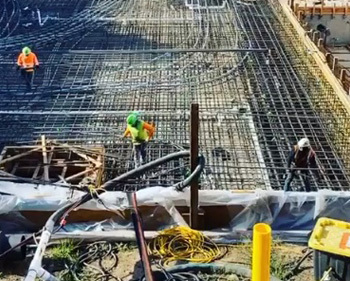5 Tips for Construction Safety During COVID-19
03
February,
2023
2 MINUTE READ

Installing sewer lines, reinforcing structures, and excavation for utility trenching are activities that are essential once again. After a weeks-long stay at home order, thousands of vacant construction sites throughout the country are coming back to life - with coronavirus pandemic precautions. Workers are acting on new construction site safety protocols, on top of the pressures to meet strict deadlines at the start of summer.
Planning Ahead
Most successful construction companies plan early, and have a long-term vision of where they want to be and how to get there, but COVID-19 threw a wrench in those plans. It is not just construction companies that are making changes to safety to help stem the spread of COVID-19. Project clients are also working with them to stem risks at construction sites.
"Our clients have changed by adding security to check the temperature of anyone entering a site, reducing the number of employees on-site, and adding masks to our required PPE lists," Charles Sukhram, a construction operator in California, said about his company's workplace safety plans during the pandemic. "Some clients have gone as far as having designated portable restrooms for each contracted company on site."
Sukhram said his company is also only allowing the use of specific trucks, implementing sanitizing procedures, and has a rule of one employee per truck during travel, rules that were not in place before the pandemic. "It is comforting to those who are in the higher-risk groups," he said. "I do feel safe, and our supervisor tries to keep us up to date with info on the sites we go to, as far as if they have had any known infections of their employees or other people on site."
Increasing Controls

Construction sites are increasing and adjusting engineering controls as the pandemic continues while also mitigating exhaustion in hot weather. Here are a few examples of ways job sites and other workplaces can increase safety:
Toolbox Talks: Avoid congregating large groups of workers for safety meetings, supervisorial walks, and planning talks. Break up debriefing and prework meetings into smaller groups. Text important work policies and instructions to workers.
Support Better Hygiene: Add extra handwashing stations and portable restrooms. Include sanitizing supplies and instructions. Direct people to those stations using signs and other markings that workers will notice.
Social Distancing: Use signs to mark break areas and specific stations for hydration, PPE, tools, emergency kits, and more. Create physical barriers using A-frame signs, plexiglass, and other tools to help move workstations and signal safe spatial areas.
Improve Rest Areas: Keep the air flowing in rest areas and heat shelters, using proper ventilation to help control temperatures. Be sure to keep on hand cooldown materials such as ice packs, wet cloths, and cool water. When possible, adjust work hours to avoid the hottest part of the day.
Training: Train workers on proper COVID-19 safety, expectations, and other important job site awareness for construction safety. Remind workers to recognize symptoms of heat exhaustion or heat stroke during high heat or high humidity.
As this year inevitably brings with it a change in plans for corporate resolutions and company goals, all in the construction industry need to continue to pave the way in safety and efficiency for the months ahead. Establish a teamwork mentality to mitigate the stresses of COVID-19, heat hazards, and other risk factors. Manage risks and streamline operations, maintain good housekeeping, and demonstrate top safety best practices. Quickly and conscientiously address hazards as they arise throughout all construction processes, and use thorough and consistent COVID-19 and other communication to achieve common workplace goals.
Improve safety and compliance with OSHA's Regulations for Construction using our free Construction Safety Managers guide.
RELATED RESOURCES

6 Steps for Improving Construction Housekeeping
Construction sites can get messy pretty quickly if proper housekeeping is not routinely enforced. Pre and ...
ReadWhat is Next for OSHA, Compliance in 2020?
OSHA is increasing inspections and offering more training assistance. Workplaces can get ahead on compliance ...
Read
Tips to Leave Valley Fever in the Dust
California is mandating Valley fever training for construction workers. Learn about what Valley fever is, how ...
Read.png)


